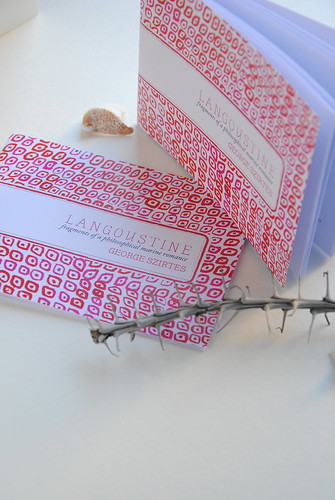Given that our open reading period is on right now, I thought it might be interesting for you to know what it’s like to publish with MIEL. Of course, every press, large or small, has its own practices. Some are more hands-on, some less. Different presses give writers and artists different kinds of control over the book as it will be. It’s not always a clear path, and understanding up front what your relationship is as a writer to the press that will publish your work can be helpful.
First of all, I’m Éireann. I’m the editor and designer for MIEL. My experience with editing began in undergraduate and MFA workshops; after finishing my MFA in 2006, I’ve done freelance editing for writers from the US and UK. Some feedback is here. I’m also a writer. My writing and editing work intersect at the point of my concern for language and my love of literature.
I take editing seriously, and when I acquire a manuscript for MIEL I read it carefully, with an eye to understanding what the book is trying to do/is doing, independent of my hopes for books-in-general. I try to feel or see or understand what it was that struck me or attracted me to the book in the first place, and to follow that through the manuscript. I flag up questions and places where the book seems to fall short of whatever its intentions appear to me to be. My notes can be extensive; I use track-changes in MS Word, and often fill the whole margin. I also write a letter to you, talking through my understanding of the book and contextualizing my editorial suggestions. (When I got the first feedback and letter from my own editor, I was taken aback and a little defensive—but I can see in hindsight as a writer and as an editor how helpful and perceptive my editor’s feedback really was. I aim to follow in his footsteps: my criticisms are given in good  faith, and I’m happy to talk about them. Like his were, though, my suggestions are sometimes not up for negotiation. For instance, the manuscript that became Music for Landing Planes By was initially titled [I cringe] The Way to Really Love It. When my editor told me that title wouldn’t sell—and, after all, presses are in business and books need to sell—I was upset. But I went back with my other choice of title, and, as you can see, he loved it. Anyway, all that to say: the editorial process at MIEL is involved and incisive, but I promise to read the work openly, to offer any criticism/suggestions in good faith, and to welcome discussion with our writers during that process.)
faith, and I’m happy to talk about them. Like his were, though, my suggestions are sometimes not up for negotiation. For instance, the manuscript that became Music for Landing Planes By was initially titled [I cringe] The Way to Really Love It. When my editor told me that title wouldn’t sell—and, after all, presses are in business and books need to sell—I was upset. But I went back with my other choice of title, and, as you can see, he loved it. Anyway, all that to say: the editorial process at MIEL is involved and incisive, but I promise to read the work openly, to offer any criticism/suggestions in good faith, and to welcome discussion with our writers during that process.)
So the editing process with MIEL generally plays out over the course of a year, or sometimes a bit longer. I’ll reply to all submissions by December or January, and then it’s likely you won’t hear from me for a while. I won’t have forgotten: I’m just working on other things (we already have books for spring/summer 2015, and those will need my attention from December 2014 onwards). About three months before your publication date I’ll be in touch with edits (and you’ll have a month to reply). Sometime after that you’ll see a cover draft. A month or so later, depending on the schedule here and on when I have your responses to edits, I’ll send galleys. You’ll get another look at the galleys before the publication date.
MIEL’s chapbooks are for the most part hand-bound (the microseries chapbooks are the exception). Production ranges from letterpress to commercial digital printing, but in all cases I choose materials that look and feel good. I produce small commemorative/ promotional objects to coincide with the publication of most chapbooks: prints, broadsides, small cards. These are sent out with orders (and to our writers) to introduce readers to things we publish that they might not have seen.
 The MIEL chapbooks and books do have ISBNs, for the most part. Chapbooks in the microseries do not have ISBNs (it’s not fiscally possible: an ISBN adds almost 1/3 of the cost of production again, and it already costs about €3 per book to have these printed. Binding is done by me, so that’s “free”, insofar as I’m not paid for any of my MIEL work).
The MIEL chapbooks and books do have ISBNs, for the most part. Chapbooks in the microseries do not have ISBNs (it’s not fiscally possible: an ISBN adds almost 1/3 of the cost of production again, and it already costs about €3 per book to have these printed. Binding is done by me, so that’s “free”, insofar as I’m not paid for any of my MIEL work).
Our books are held in many collections in the US and EU. Our customers come from all over—North America, Europe, Asia, South America. I promote the books on Twitter, Facebook, here, and in our email newsletters, and I invite writers to contribute posts for this blog—talking about their work, the book MIEL is publishing, or anything else they are interested in. I take the books to book fairs (in London in the fall and winter; I’ll also be at AWP 2015 in Minneapolis). I send copies out for review. I’m happy to work with writers who might have their own networks to get the news about their book out.
MIEL cannot pay money for your work. That’s an important point. I want to pay writers, and at some point in the next few years that will happen. For now, we pay 10-20% of print run to our writers and artists. At the moment, the combination of Belgian tax codes and the fact that it’s rare for one of the books to make much more than the cost of printing and supplies in sales makes it impossible to pay cash. But writers, I want to emphasize: no one in this arrangement gets paid. Any money made selling your books covers printing them, supplies for binding them, packaging for them, postal costs for sending review copies out, and then the leftover rolls over to pay for the next book. I don’t get paid. Jonathan, who occasionally helps me arrange the financial side of things, certainly doesn’t get paid. Our accountant gets paid, but that is c.f. Belgian tax codes.
So that’s how it works here. If it sounds good to you, send me something to read.

